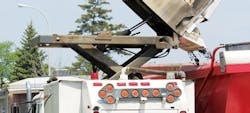Urban runoff, in addition to storm water runoff, has increasingly been a hot button topic for many urban planners, the U.S. Environmental Protection Agency and public works figures. The push for greener management of waters also has a connection to the power sweeping industry. Fine particulates and other debris from urban surfaces are a primary source of harmful pollution and congestion in waterways. In recent years, a variety of surveys and experiments has been conducted to try to solve this ever-increasing problem. Phosphorous in urban storm water runoff is a particular concern in many of these studies due to its scientifically documented negative impact on the environment and drinking water sources. The primary question of the surveys is: What is an effective and cost-efficient method to remove particulates and phosphorous from urban and storm water runoff?
A recent survey by the U.S. Geological Survey (USGS) titled, “Potential Reductions of Street Solids and Phosphorus in Urban Watersheds from Street Cleaning, Cambridge, Mass, 2009-2011,” highlights points of interest for the street cleaning and storm water management industries. Most importantly, the conclusion of the survey is that street sweeping is a good front line defense against urban and storm water runoff, which have proven to be the source of so much pollution. Street sweeping also is effective and cost-efficient, even when compared with the likes of catch basin systems and complex water treatment systems.
Survey Findings
Some findings of the survey that might seem surprising, even to veterans of the street sweeping industry, included the fact that debris and particulates were found on the streets regardless of the presence of curbs and gutters. Curbless streets are as likely to harbor particulates and debris as their curbed counterparts. It also was discovered that various urban settings contribute to particulate runoff differently.
To expand upon the difference in urban settings and their contribution to urban runoff, one can look at residential areas versus commercial. Streets used commercially yielded differences when compared with residential streets with multiple families. On average, around 740 lb of material were collected per curb mile in residential settings, versus 522 lb per curb mile for commercial streets. It was found that residential properties contribute more to phosphorous and particulate runoff—on average 29% to 35% more than commercial properties. This is not due solely to volume, but rather to the increased presence of grass clippings, tree leaves, fertilizer and more. Street sweepers were found to be more effective on residential streets than on commercial streets due in part to the larger particulate size of the debris on residential streets—a difference of 82% pick up for residential streets versus 78% pick up for commercial streets.
Industry Thoughts
While sweeping results will vary by season and region, the evidence shows that street sweeping is a solid first line of defense when it comes to effectively managing particulate pollution in urban and storm water runoff. In addition to the insights the USGS abstract offers, professionals of the 1.800.SWEEPER Nationwide Service Alliance had several thoughts on best practices to enhance sweeping efforts.
One of the leading suggestions was investing in employees. “Effective street sweeping begins with recruiting the right employees, as well as with thorough training of the employees,” said Mike Lucht, president of Progressive Sweeping in Toledo, Ohio, and 1.800.SWEEPER. “They should have an eye for detail and experience with the machine being operated. Not every jobsite is the same, which makes an employee with experience and proper training in power sweeping a valuable asset.”
“When planning routes for your sweeping trucks, there are several considerations,” said Gerry Kesselring of Contract Sweeper in Columbus, Ohio, and a 1.800.SWEEPER board member. “First, limit the backtracking a sweeper has to do. Second, allow for the sweeper to make right-hand turns whenever possible. Another consideration is to route sweepers so that they complete the route near dedicated dumping locations, or place dumpsters and dump trucks in a central location along routes. Additionally, we have found it to be most effective if we do not sweep residential streets the same day as residential trash pickup.
“Contractors should have a mix of sweepers to handle different types of debris and sweeping conditions,” Kesselring added. “Another interesting point is that recent studies have shown that 90% of the debris is within 9 ft of the curbline.”
Kerry Porter is marketing manager for Toledo, Ohio, and Detroit for Progressive Sweeping LLC. Porter can be reached at [email protected].
Download: Here


